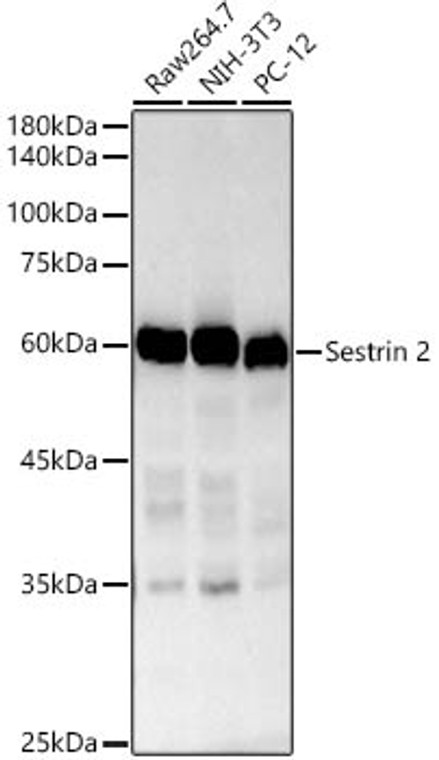| Host: |
Rabbit |
| Applications: |
WB |
| Reactivity: |
Human/Mouse/Rat |
| Note: |
STRICTLY FOR FURTHER SCIENTIFIC RESEARCH USE ONLY (RUO). MUST NOT TO BE USED IN DIAGNOSTIC OR THERAPEUTIC APPLICATIONS. |
| Short Description: |
Rabbit monoclonal antibody anti-Sestrin-2 is suitable for use in Western Blot research applications. |
| Clonality: |
Monoclonal |
| Clone ID: |
S5205RM |
| Conjugation: |
Unconjugated |
| Isotype: |
IgG |
| Formulation: |
PBS with 0.05% Proclin300, 0.05% BSA, 50% Glycerol, pH7.3. |
| Purification: |
Affinity purification |
| Dilution Range: |
WB 1:1000-1:5000 |
| Storage Instruction: |
Store at-20°C for up to 1 year from the date of receipt, and avoid repeat freeze-thaw cycles. |
| Gene Symbol: |
SESN2 |
| Gene ID: |
83667 |
| Uniprot ID: |
SESN2_HUMAN |
| Immunogen: |
Recombinant protein of human Sestrin 2 |
| Tissue Specificity | Widely expressed. |
| Post Translational Modifications | Phosphorylated by ULK1 at multiple sites. Ubiquitinated at Lys-175 by RNF167 via 'Lys-63'-linked polyubiquitination in response to leucine deprivation: ubiquitination promotes SESN2-interaction with the GATOR2 complex, leading to inhibit the TORC1 signaling pathway. Deubiquitinated at Lys-175 by STAMBPL1, promoting the TORC1 signaling pathway. Ubiquitinated by RNF186.ubiquitination mediates proteasomal degradation. |
| Function | Functions as an intracellular leucine sensor that negatively regulates the mTORC1 signaling pathway through the GATOR complex. In absence of leucine, binds the GATOR subcomplex GATOR2 and prevents mTORC1 signaling. Binding of leucine to SESN2 disrupts its interaction with GATOR2 thereby activating the TORC1 signaling pathway. This stress-inducible metabolic regulator also plays a role in protection against oxidative and genotoxic stresses. May negatively regulate protein translation in response to endoplasmic reticulum stress, via mTORC1. May positively regulate the transcription by NFE2L2 of genes involved in the response to oxidative stress by facilitating the SQSTM1-mediated autophagic degradation of KEAP1. May also mediate TP53 inhibition of TORC1 signaling upon genotoxic stress. Moreover, may prevent the accumulation of reactive oxygen species (ROS) through the alkylhydroperoxide reductase activity born by the N-terminal domain of the protein. Was originally reported to contribute to oxidative stress resistance by reducing PRDX1. However, this could not be confirmed. |
| Protein Name | Sestrin-2Hypoxia-Induced Gene |
| Database Links | Reactome: R-HSA-5628897Reactome: R-HSA-9639288Reactome: R-HSA-9755511 |
| Cellular Localisation | Cytoplasm |
| Alternative Antibody Names | Anti-Sestrin-2 antibodyAnti-Hypoxia-Induced Gene antibodyAnti-SESN2 antibodyAnti-Hi95 antibodyAnti-SEST2 antibody |
Information sourced from Uniprot.org
12 months for antibodies. 6 months for ELISA Kits. Please see website T&Cs for further guidance







